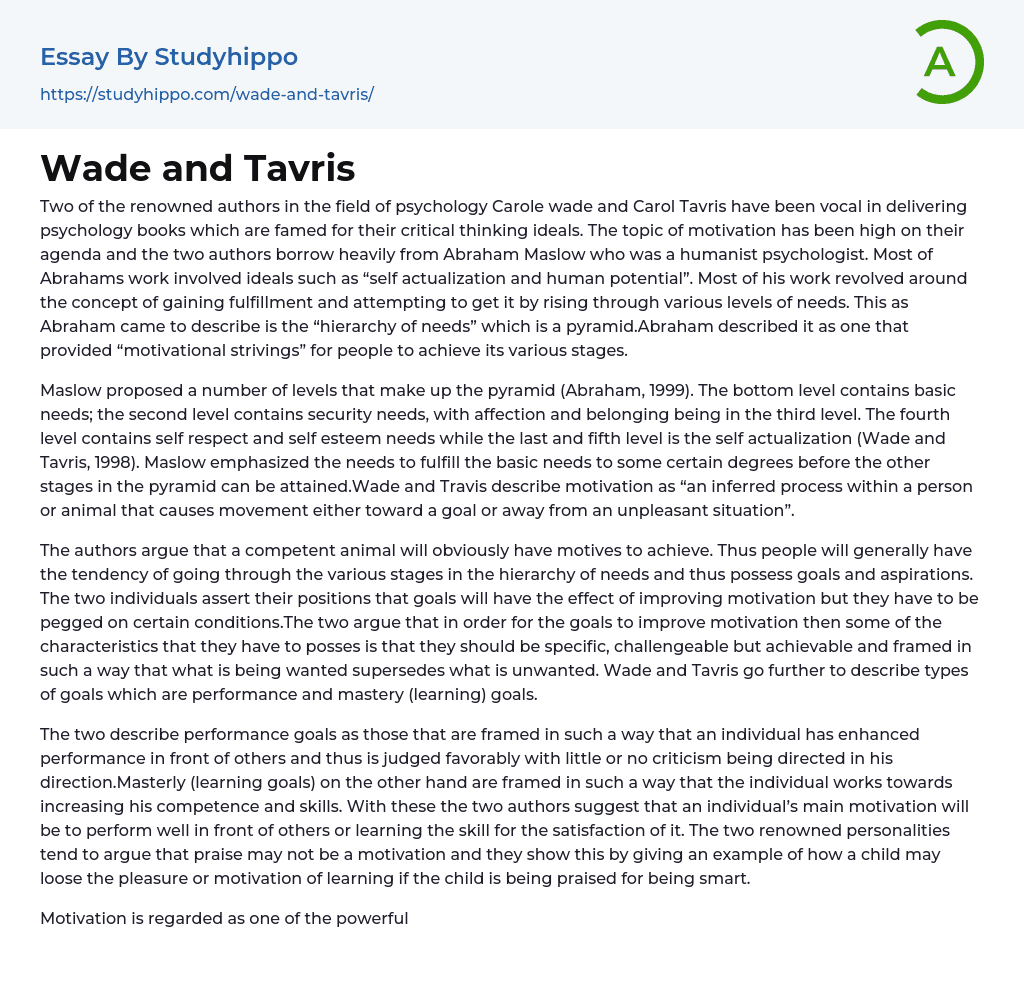Two of the renowned authors in the field of psychology Carole wade and Carol Tavris have been vocal in delivering psychology books which are famed for their critical thinking ideals. The topic of motivation has been high on their agenda and the two authors borrow heavily from Abraham Maslow who was a humanist psychologist. Most of Abrahams work involved ideals such as “self actualization and human potential”. Most of his work revolved around the concept of gaining fulfillment and attempting to get it by rising through various levels of needs. This as Abraham came to describe is the “hierarchy of needs” which is a pyramid.Abraham described it as one that provided “motivational strivings” for people to achieve its various stages.
Maslow proposed a number of levels that make up the pyramid (Abraham, 1999). The bottom level contains basic
...needs; the second level contains security needs, with affection and belonging being in the third level. The fourth level contains self respect and self esteem needs while the last and fifth level is the self actualization (Wade and Tavris, 1998). Maslow emphasized the needs to fulfill the basic needs to some certain degrees before the other stages in the pyramid can be attained.Wade and Travis describe motivation as “an inferred process within a person or animal that causes movement either toward a goal or away from an unpleasant situation”.
The authors argue that a competent animal will obviously have motives to achieve. Thus people will generally have the tendency of going through the various stages in the hierarchy of needs and thus possess goals and aspirations. The two individuals assert their positions that goals will have the effect o
improving motivation but they have to be pegged on certain conditions.The two argue that in order for the goals to improve motivation then some of the characteristics that they have to posses is that they should be specific, challengeable but achievable and framed in such a way that what is being wanted supersedes what is unwanted. Wade and Tavris go further to describe types of goals which are performance and mastery (learning) goals.
The two describe performance goals as those that are framed in such a way that an individual has enhanced performance in front of others and thus is judged favorably with little or no criticism being directed in his direction.Masterly (learning goals) on the other hand are framed in such a way that the individual works towards increasing his competence and skills. With these the two authors suggest that an individual’s main motivation will be to perform well in front of others or learning the skill for the satisfaction of it. The two renowned personalities tend to argue that praise may not be a motivation and they show this by giving an example of how a child may loose the pleasure or motivation of learning if the child is being praised for being smart.
Motivation is regarded as one of the powerful tools that has the capability of enhancing performance and when the right form of motivation is found then the individual will achieve higher. Self efficacy which is an individuals belief that he they are capable of attaining goals, being efficient and learning new skills is one of the best motivations that an individual can have (Bandura, 1997). However the motivation will only work
when the goals that are desired are achievable and thus the expectation that is pegged to the motivation should coincide with the attainability of the goal.
- Emergence essays
- Anxiety Disorder essays
- Post-traumatic Stress Disorder essays
- Academia essays
- Higher Education essays
- Language Learning essays
- Studying Business essays
- Education System essays
- Study essays
- First Day of School essays
- Scholarship essays
- Pedagogy essays
- Curriculum essays
- Coursework essays
- Studying Abroad essays
- Philosophy of Education essays
- Purpose of Education essays
- Brainstorming essays
- Educational Goals essays
- Importance Of College Education essays
- Brown V Board of Education essays
- The Importance Of Higher Education essays
- Online Education Vs Traditional Education essays
- Academic And Career Goals essays
- Academic Integrity essays
- Brown Vs Board Of Education essays
- Distance learning essays
- Technology in Education essays
- Vocabulary essays
- Writing Experience essays
- Importance of Education essays
- Early Childhood Education essays
- Academic Degree essays
- Academic Dishonesty essays
- School Uniform essays
- Academic writing essays
- Cheating essays
- Bachelor's Degree essays
- MBA essays
- College Life essays
- Grade essays
- Diploma essays
- Phonology essays
- Sentence essays
- Filipino Language essays
- Pragmatics essays
- Millennium Development Goals essays
- History Of Education essays
- Graduate School essays
- Middle School essays




